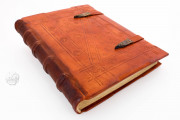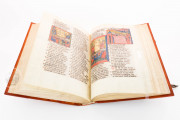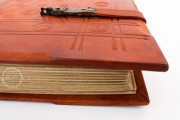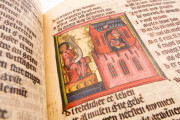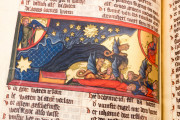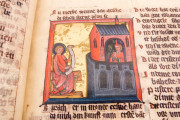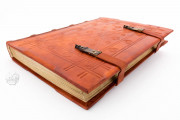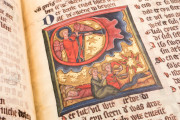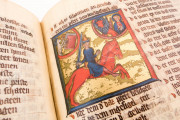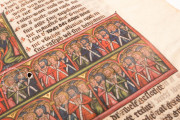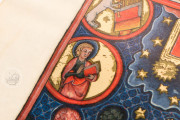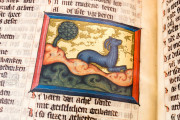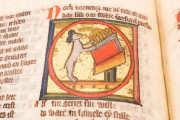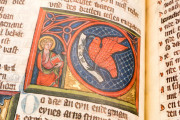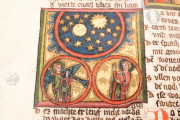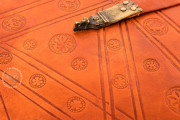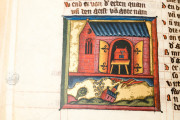The Toruń Apocalypse is a mid-fourteenth-century manuscript comprising a translation with commentary of the Christian biblical book of the Apocalypse into rhyming German prose by Heinrich von Hesler. It includes thirty-five in-text miniatures depicting scenes of the Apocalypse and the Last Judgment, most of which are column miniatures, although some span both columns of text on a page or extend across to the facing page.
The History of the Author
The author of the Apocalypse, Heinrich von Hesler, likely came from a noble family from Hesler, in German Thuringia. Until recently it was believed that he was born around 1270 and died after 1347. It was also believed that he was a member of the Teutonic Order and was the provost and commander in Zschillen, in the Teutonic Bailiwick of Turin. Heinrich von Hesler was referenced to have occupied these posts in the 1330s and 1340s. It was widely believed that his works originated from the first decades of the 14th century.
The Apocalypse and the Teutonic Order
The Apocalypse was supposedly created at the beginning of that century. Apart from the Apocalypse, the History of Salvation and hypothetically the Gospel of Nicodemus are also attributed to Heinrich von Hesler. Hesler's work was considered to be an integral part of the literature of the Teutonic Order. However, the last two discovered fragments of von Hesler’s the Apocalypse indicate that he might have written it as early as the 1260s. Accordingly, this discovery forced researcher to revisit their views on this period in Heinrich von Hesler’s life, the origin date of the Apocalypse and maybe even the circle in which it was created.
The Apocalypse is a German translation in rhymed prose of The Apocalypse of St. John, the last book of the New Testament. However, it is not a literal and complete translation. Heinrich von Hesler made the translation by interweaving it with the texts of medieval theologians and his own comments. An analysis of The Apocalypse attests to the profound and vast theological knowledge of the author. Hesler's literary proficiency is also worth mentioning; his verses and rhymes are of the highest quality, and his Apocalypse features the so-called melodics, a quality rendering it particularly attractive when read aloud.
Undoubtedly, the creation of the illuminated series of Heinrich von Hesler’s Apocalypses, which includes the two manuscripts discussed herein, can be traced to the order of Luther von Braunschweig, the Grand Master of the Teutonic Order throughout 1331-1335. Luther von Braunschweig was inspired with the Western European chivalric and court tradition which prompted him to use using the illuminations from the Apocalypse to presents ideas cherished by order knights.
The Unicity of the Miniatures
What distinguishes the Teutonic miniatures from their Western European counterparts is their close relation to the text. The illuminator who created the miniatures for the Apocalypse was probably inspired by similar English codices. However, the miniatures in the Teutonic series had a separate program – the illuminator introduced additional presentations and contents imposed by the sponsors. Apart from the vision of the City of God and the forces of evil, knights were shown as fighting and converting, acting for the benefit of the future fate of the Church on the Earth and as its integral part – they were included in God’s plans. The illumination of the series of Teutonic Apocalypses is the oldest example of the painted presentation of the ideology of the Teutonic Order.
The Copies
Apart from the two “Torun” copies of the Heinrich von Hesler’s the Apocalypse, a third illuminated copy of this work survives today. It is kept in the Württembergische Landesbibliothek in Stuttgart. Recent studies on the subject hypothesize that during the life of Luther von Braunschweig only the Stuttgart copy was created and the two Torun copies were manufactured only after his death. Another two non-illuminated copies of the Apocalypse survive: the 14th copy currently resides in the Library of the Polish Academy of Sciences in Gdansk and the 15th century copy is located in the University Library in Munich, as well as over a dozen fragments of this work.
Codex reference number Rps 64/III containing Heinrich von Hesler’s Apocalypse was made by two writers. The writing used in the manuscript is the textualis, i.e. a book hand. The text of the Apocalypse was written in two columns. The manuscript boasts 35 beautiful gilded miniatures, painted by an unknown illuminator who probably came from Western Germany. 12 leaves are missing; these were either cut-out or torn. All these leaves featured miniatures. The first three leaves of the manuscript are blank.
Codex reference no. Rps 44/III contains Heinrich von Hesler’s Apocalypse and the so-called Königsberger Apokalypse (also known as Prosa-Apokalypse), i.e. the medieval prose translation of the Apocalypse of St. John to German. This manuscript was written in textualis by two writers. The text was written in two columns. The manuscript currently contains 45 miniatures. Only one leaf containing a miniature is missing.
The Importance of the Sister Manuscripts
Both the above-mentioned manuscripts are sister manuscripts as the copies of the Apocalypse contained in them were written on the same number of leaves and have exactly the same number of miniatures in the same places. The differences between them, apart from the cut-out leaves, stem only from the fact that manuscript reference number Rps 44/II additionally contains the Königsberger Apokalypse and the miniatures in this copy were made by a different illuminator, though from the same workshop. The illuminations in this copy exhibit inferior workmanship and are not gilded, they also lack the precision of the miniatures in codex reference number Rps 64/III. It is assumed that both the copies were copied from a third one that failed to survive to today.
Both codices were created in Ducal Prussia. Probably from the beginning they were stored in the library of the Teutonic Order in Marienburg. This is confirmed by the inventory of books stored in Marienburg taken from 1394 and 1398. After the Thirteen Years' War they were moved to a library in Tapiau. On 8 October 1541 they were moved from Tapiau to the newly-created Castle Library in Königsberg. They remained in Königsberg until World War II. At the end of the war, for security reasons, the codices along with valuable books from Königsberg were deposited by the Germans in Karwiny near Paslek which was incorporated into the Polish state in 1945. In 1947 this fragment of the Königsberg collections, from the so-called warehousing center for protected book collections in Paslek, was transported to the University Library in Torun.
We have 1 facsimile edition of the manuscript "Toruń Apocalypse": Apokalypsa - Heinrich von Hesler facsimile edition, published by Orbis Pictus, 2013
Request Info / Price

